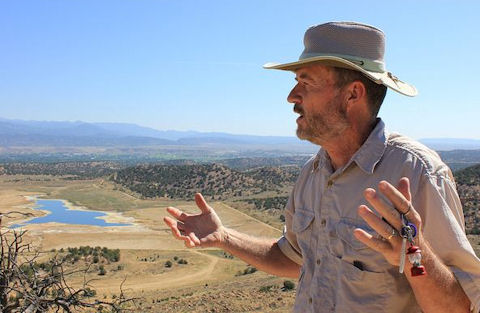What can a Superfund site in Colorado tell us about potential uranium mining and milling in Virginia?
by Rose Jenkins
Sharyn Cunningham and her family drank from a poisoned well for eight years. When they bought property in Cañon City, Colo., in 1994, they had their two wells tested—but just for normal water quality issues, not for radioactivity or heavy metals. They didn’t know that the groundwater below their home had been infiltrated by toxic waste from the Cotter Corporation’s uranium mill on the edge of town.
“There were a lot of people using their wells,” she told me. “I never thought about uranium.”
I was in Cañon City on the first of a series of stops of visits to communities in the West that have experience with the uranium industry. My purpose was to inform the debate over whether to allow uranium mining and milling in my home state of Virginia. In stories like Cunningham’s, there may be important lessons learned that Virginians should take to heart.
The history of the uranium mill, or processing plant, in Cañon City can be recounted as one failure after another in containing hazardous wastes. Early on, in the 1950s, the Cotter Corporation simply dumped mine tailings—the dirt and rock remaining after concentrated “yellowcake” is extracted from uranium ore—on the ground. During heavy rains, a toxic flood washed into the neighborhoods below. In 1971, Fremont County constructed an earthen dam to stop flooding, but contaminated water seeped through, underground. Later, the company built a wall with technology to filter out contaminants, but the filter clogged. Today, water that flows downhill from the site is pumped back into impoundment ponds.
But the tailings may still be releasing unseen contaminants into the groundwater. The piles were moved into huge pits equipped with a rubber liner, in 1979. But a series of recent studies indicates that the lined pits are leaking or are likely to leak.
In 1984, the U.S. Environmental Protection Agency (EPA) designated the Cotter Mill site and the adjacent Lincoln Park neighborhood a Superfund site. But when Cunningham bought her home in Lincoln Park ten years later, she didn’t know that. She never thought about Cotter until 2002, she says, when the company announced a plan to import and store toxic waste from other parts of the country, starting with almost half a million tons of contaminated earth shipped out of New Jersey. In response, she helped to found the grassroots group Colorado Citizens Against Toxic Waste (CCAT). When the CCAT board met with a representative from the state health department, she learned for the first time that her well posed a health hazard.
“He said, ‘Well, nobody’s using their wells in Lincoln Park,’” Cunningham recalls. “And I raised my hand and said, ‘Um… we are.’ And he kind of freaked out.”
In the years that followed, hundreds of area residents who got sick—with cancers, bone diseases, kidney diseases, autoimmune diseases, and other problems—filed class action lawsuits. After years in court, they won settlements, although the company did not admit any fault.
Cunningham believes that her family’s health was also harmed, but she stayed out of the lawsuits—focusing instead on forcing the company to stop poisoning the ground, air, and water of Cañon City.
CCAT’s citizen activists succeeded in stopping the Cotter Corporation from importing hazardous wastes—materials so toxic that it was worth hundreds of millions of dollars for the places they came from to get rid of them.
As Cunningham describes it, elected officials assumed that public opinion would be evenly split between people who opposed the import plan on grounds of public health and people who supported it on grounds of economic development. Instead, CCAT rallied an overwhelming consensus against it. In a community of about 18,000, the organization gathered 5,000 signatures on a petition opposing the plan, including many business owners, health care workers, and educators. In 2005, the state denied the permit. CCAT went on to successfully advocate for three state laws affecting the uranium mill.




